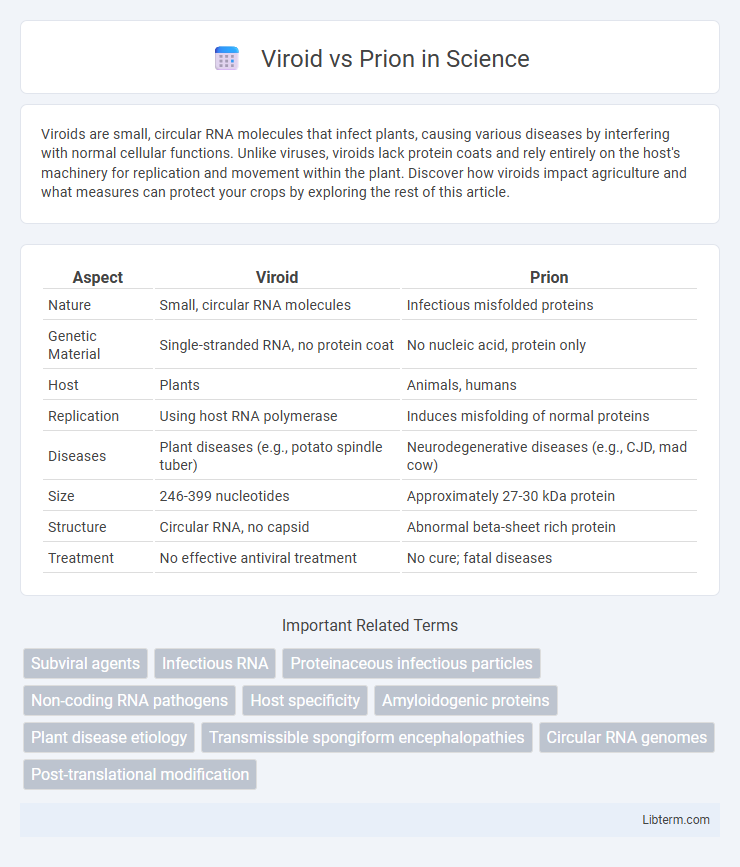Viroids are small, circular RNA molecules that infect plants, causing various diseases by interfering with normal cellular functions. Unlike viruses, viroids lack protein coats and rely entirely on the host's machinery for replication and movement within the plant. Discover how viroids impact agriculture and what measures can protect your crops by exploring the rest of this article.
Table of Comparison
| Aspect | Viroid | Prion |
|---|---|---|
| Nature | Small, circular RNA molecules | Infectious misfolded proteins |
| Genetic Material | Single-stranded RNA, no protein coat | No nucleic acid, protein only |
| Host | Plants | Animals, humans |
| Replication | Using host RNA polymerase | Induces misfolding of normal proteins |
| Diseases | Plant diseases (e.g., potato spindle tuber) | Neurodegenerative diseases (e.g., CJD, mad cow) |
| Size | 246-399 nucleotides | Approximately 27-30 kDa protein |
| Structure | Circular RNA, no capsid | Abnormal beta-sheet rich protein |
| Treatment | No effective antiviral treatment | No cure; fatal diseases |
Introduction to Viroids and Prions
Viroids are small, circular RNA molecules that infect plants, lacking a protein coat and relying on host machinery for replication. Prions are infectious proteins that cause neurodegenerative diseases in animals by inducing abnormal folding of normal cellular proteins. Both represent unique classes of pathogens differing significantly in structure and replication mechanisms.
Definition and Basic Structure
Viroids are small, circular RNA molecules without a protein coat that infect plants and disrupt gene regulation. Prions are misfolded proteins devoid of nucleic acids, responsible for neurodegenerative diseases in animals by inducing abnormal folding of normal proteins. Both entities lack conventional cellular structures but differ fundamentally in composition: viroids consist solely of RNA, while prions consist solely of protein.
Discovery and Historical Background
Viroids were first discovered in 1971 by Theodor O. Diener as small, circular RNA molecules causing plant diseases, marking a significant breakthrough in understanding subviral pathogens. Prions were identified in 1982 by Stanley B. Prusiner, who demonstrated these infectious proteins cause neurodegenerative diseases like Creutzfeldt-Jakob disease, revolutionizing the concept of infectious agents lacking nucleic acids. The discovery of both viroids and prions challenged traditional infectious disease paradigms and expanded molecular biology's scope.
Genetic Material: RNA vs Protein
Viroids consist of small, circular RNA molecules that lack protein coats and rely solely on their RNA to infect host plants and replicate. In contrast, prions are misfolded proteins without any nucleic acids, causing neurodegenerative diseases by inducing abnormal folding of normal proteins in the brain. The fundamental difference in genetic material--RNA for viroids and protein for prions--defines their distinct mechanisms of infection and replication.
Mechanisms of Pathogenicity
Viroids cause disease by interfering with the host plant's RNA metabolism through RNA silencing mechanisms, leading to gene expression disruption and cellular dysfunction. Prions induce pathogenicity by misfolding normal cellular proteins into abnormal conformations, triggering a chain reaction that results in neurodegenerative diseases through protein aggregation and neuronal damage. Both agents lack nucleic acids, but viroids rely on RNA-mediated gene silencing while prions propagate through protein conformation templating.
Transmission and Spread
Viroids, infectious RNA molecules, primarily spread through plant propagation methods such as grafting, contaminated tools, and seed transmission, causing diseases in crops. Prions, misfolded proteins responsible for neurodegenerative diseases like Creutzfeldt-Jakob and Bovine Spongiform Encephalopathy, transmit through ingestion of contaminated tissues, medical procedures, or inherited mutations. Both have unique mechanisms of spread: viroids rely on plant-to-plant transmission, while prions propagate within animal hosts and across species barriers through exposure to infectious proteins.
Diseases Caused by Viroids and Prions
Viroids cause plant diseases such as Potato Spindle Tuber, Coconut Cadang-Cadang, and Avocado Sunblotch, primarily disrupting plant growth and yield. Prions are responsible for fatal neurodegenerative diseases in animals and humans, including Creutzfeldt-Jakob Disease (CJD), Bovine Spongiform Encephalopathy (Mad Cow Disease), and Scrapie in sheep. Both viroids and prions lack nucleic acids in typical pathogen forms, challenging traditional disease control methods.
Detection and Diagnosis Methods
Viroid detection primarily relies on molecular techniques such as reverse transcription polymerase chain reaction (RT-PCR) and nucleic acid hybridization assays to identify their RNA genomes in infected plant tissues. Prion diagnosis involves biochemical methods including proteinase K digestion assays, Western blotting for abnormal prion protein (PrP^Sc), and immunohistochemistry to detect misfolded prion aggregates in brain samples. Advanced techniques like real-time quaking-induced conversion (RT-QuIC) enhance prion sensitivity and specificity, enabling early detection in biological fluids such as cerebrospinal fluid.
Prevention and Control Strategies
Viroid prevention relies on strict agricultural hygiene, including disinfecting tools and using certified disease-free planting materials to control the spread in crops. Prion control focuses on stringent biosecurity measures such as banning infected animal products, proper disposal of contaminated materials, and surveillance to limit transmission of diseases like Creutzfeldt-Jakob and BSE. Both require early detection and containment to reduce outbreaks, emphasizing monitoring and regulatory compliance in affected environments.
Key Differences and Summary Comparison
Viroids are small, circular RNA molecules without a protein coat, primarily causing diseases in plants by interfering with gene expression, whereas prions are misfolded proteins that induce abnormal folding of normal proteins in animals, leading to neurodegenerative conditions. Viroids lack any protein-coding ability and replicate through host RNA polymerases, while prions propagate by catalyzing the misfolding of specific host proteins without nucleic acids. The fundamental difference lies in viroids being infectious RNA agents affecting plants, contrasted with prions as proteinaceous infectious particles responsible for diseases like mad cow disease and Creutzfeldt-Jakob disease in mammals.
Viroid Infographic

 libterm.com
libterm.com